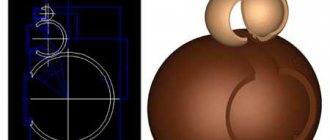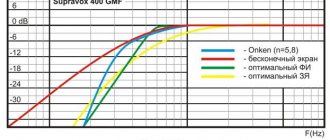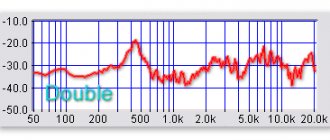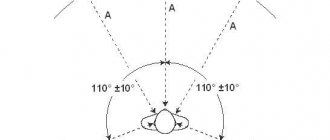My hands are itching, but my soul is demanding... Repetition of the Troelsa CNO-T25 project. The article will describe the stages of construction from the purchase of components to tests and measurements.
A little background...
While assembling a DIY KIT BIFROST from SEAS, I found a friend on Avito from whom I wanted to buy acoustic terminals, came, got to talking, and it turned out that he had a Troelsa CNO-T25 project that he suggested listening to. I turned on my playlist from TIDAL and just didn’t want to leave, pleasant sound, accurate, fast bass with gorgeous vocals. I left in a very good mood, because I was building a similar project but with even better top-end tweeters T29CF002.
Having made BIFROST, at the first listens it became clear that the CNO-T25, which I had listened to earlier, sounds much more interesting to me in terms of mids and lows. I decided to ask a friend from Avito for a comparative test of CNO-T25 and BIFROST, the test confirmed my previous feelings, the CNO-T25 has better bass, it is more accurate, faster (very noticeable in electronic music), more interesting vocals (BIFROST seems to have a muffled voice, the feeling that you are listening with deafened ears), in the HF there was no difference for me. In both projects, the frequency response was as close as possible to the author’s, which indicated correct assembly. This time I left in a bad mood and was already in the car writing an advertisement for the sale of BIFROST. The next day the acoustics were sold to a new lucky owner...
Conclusions:
For W18NX001 18 liters is not enough, it feels better at 24, with +- the same FI setting. In the Troelsa filter, the middle is less compressed, which is felt in vocal performance.
HF T29CF002 is several times more expensive than T25CF001, but the difference is not noticeable... As it turns out, Troels himself writes about this.
I have studied enough reviews about the CNO-T25, many write how great the speaker sounds, and there are those who comment on the filter and the entire Troelsa project as “utter nonsense”, “it cannot play”, “it will play, but no more...”, as it turned out, they simply had not heard of CNO-T25, but because of these reviews I did not make CNO-T25, but took up BIFROST.
I decided not to rush and start a thorough search for a speaker that would suit my requirements. I was able to listen to a lot of worthy models from different price segments (from 250 to 8 million rubles), brands and DIY.
And so I decided to build CNO-T25 , why? 5 points that I have identified for myself:
1. Ideal price/emotions ratio (that very moment when you understand how much the acoustics cost, what emotions it gives you - a perfect symbiosis);
2. Omnivorous. By adding the REL T9i active subwoofer, the system becomes omnivorous and, in my opinion, is still ideal in terms of the first point, considering the cost + 120 thousand to the speakers;
3. Design, external finishing, dimensions. The dimensions are definitely +, ideal for my listening room, externally the speaker looks neither small nor large (200x985x275). The exterior finish will be what I want, American walnut covered in piano lacquer;
4. Simplicity of design. There are no complex forms or solutions that require additional equipment or R.
5. Sound, Sound and more sound. For almost a year I went with my playlist and listened to my favorite tracks. Sexy voice of Sade which is so relaxing, goosebumps from Dulce Pontes, Metallica, Aria, Armin, Yahel, Travis Scott, you can listen to everything...
Over the past year, I have heard speakers that sounded more interesting, which I really liked, but when I realized their cost, my mind returned to the CNO-T25 + REL T9i. Why such a connection? When the room is not acoustically prepared, there is no way to radically change the location of the speakers, it is difficult to achieve the desired lows that will not “buzz”, “lag”, etc. With a good active subwoofer, you can play around with the placement and achieve maximum quality and efficiency with minimal power.
PS - Everything I wrote above is solely my opinion, which I do not impose. I am only describing my emotions, my taste, my vision. Please don’t rant too much about this))).
So, let's begin!
↑ Refinement of the RF head
I would also like to point out one design feature.
On the HF head I installed a circle made of felt 3 mm thick, equal to the diameter of the front panel of the HF head. I made a hole in the center with petals for the dome. Attached to the panel. The actions performed were not only audible, but visible from the measurement results. In my case, the unevenness of the frequency response in the region of 5 and 8 kHz has decreased. But after 12 kHz the frequency response level decreased, although very slightly. The changes were more noticeable by ear. To be honest, I didn’t even expect such improvements. It’s difficult to describe, but it can be compared to an increase in the sharpness and outlines of musical images. It's as if the resolution of the source has increased. Musical nuances that were little noticeable, especially those located widely outside the acoustics, became more noticeable. It feels like these moments were just masked earlier, but now they have become audible.
It kind of fills the music scene with micro-details. I was very interested in the topic and plans to experiment with the size, shape of felt, as well as the shape of the hole for the dome, and maybe it’s worth trying another material, for example, carpet. The only thing is that it’s hard to cut out the felt by hand. Maybe I'll try to make some kind of punch. I secure the felt with double-sided tape as a temporary solution.
3D project, housing
The author of the layout is Oleg Ogilko https://t.me/olegogilko
A detailed 3D project and drawings for production have been developed. Important parameters such as the distance between the speakers, the width of the front panel, and the usable volume have been preserved.
Author of the layout Oleg Ogilko https://t.me/olegogilko
Link to 3D online, you can look at the body in more detail, twist it, take it apart into parts. The front panel is made of MDF 25 mm, the rest 19 mm.
The body will be made at WaveCorp from American walnut coated with piano varnish. This is not the first time I order from Nikolay, the quality of workmanship is excellent!
Natural veneer American Walnut Frize
↑ Project AS
The size of the acoustics is unusual, there are more bookshelf speakers and fewer floor speakers.
In terms of size, these are still bookshelf acoustics, but ordinary stands do not fit it, so I made temporary ones of small height. To suppress a standing wave, I placed three pieces of padding polyester inside measuring 0.5*0.2 m and 30 mm thick: one from the bottom in the shape of the letter “U”, the second along the back wall and the third from the top in the shape of the letter “P”. As a result, this is the project we got:
The body was made from MDF/chipboard of the following dimensions: width - 240 mm, depth - 330 mm, height - 530 mm. The wall thickness is 22 mm, the front panel is made of two layers of MDF (22 + 16 mm) with a total thickness of 38 mm.
Bass reflex 190 mm with a diameter of 70 mm. Tuning frequency 37 Hz. The body is covered with sheet cork using Moment-Joiner glue.
Components and estimates
Link to general estimate Google docs , which will be adjusted in the process.
HF speaker SEAS Excel E0006-06 (T25CF001)
HF speaker SEAS Excel E0006-06 (T25CF001)
HF speaker SEAS Excel E0006-06 (T25CF001)
HF speaker SEAS Excel E0006-06 (T25CF001)
Externally it is very well made, good coating, thick metal flange. Some T25CF001, like the T25C003, have a dip at 16.9 kHz -6.1 dB, which is quite easily solved and described here. I didn't have it on both speakers.
↑ Some measurements
Impedance and frequency response measurements (1m, 1/24 octave smoothing)
The placement of the acoustics is designed so that the HF heads are just below the ears, so the stands are of low height.
This is a matter of preference; you can not only try with different heights, but also make a slight tilt away from the listener. The acoustics came out with fairly good sensitivity, approximately 89 dB. At 16 m2 it sounded comfortable with a one-watt 6P14P tube amplifier, plus there was a small volume reserve. The advantages include the ability to play at low volume, which is important for evening listening.
Filter and its components
PS - Resistors are indicated in green on the diagram, transparent ones indicate the resistance of the coils.
Capacitors KZK White line
Here, everything according to the author’s recommendations, except for capacitors, we will use KZK White line. I listened to it, I liked everything, the price tag for them is adequate, I will support the domestic manufacturer!
Acoustic terminal Audiocore HD-534 Gold
Acoustic terminal Audiocore HD-534 Gold
Excellent quality of materials, adequate price tag. I developed panels made of 4 mm steel with powder coating especially for them. Who needs a PDF drawing, by the way, many more terminals of a similar design will fit these panels. I ordered from the guys from Kaluga.
Panel for acoustic terminal. Made by the guys from vk.com/mill_grav
4-way speaker (Seas H1209 + Seas H1456 + ScanSpeak D7608 + SEAS H1149)
The speaker design was developed in collaboration with cyberflipper
. The history of the design begins with “Optima SE” by Georgy Krylov. First, “Optima SE” was supplemented with a low-frequency unit based on the Seas H1209 speaker. Then, from Georgiy’s three-way design, the idea was gleaned to unload the mid-frequency section based on the Seas H1456 speaker with a ScanSpeak D7608 dome midrange driver.
The design volume for H1209 was chosen as a result of listening to two cases with volumes of 40 and 75 liters, measured quality factors of 0.9 and 0.7, respectively. The 75 liter speaker sounded calm, fast and accurate, but! less “driving”. As a result, we decided to settle on 55 liters of closed box volume.
For H1456, the volume selected is 8 liters. According to the datasheet parameters, this was the optimal (0.7) ZY.
Despite the difficulties of making an inclined front panel, we decided to go for it. The phase-frequency characteristics of the speakers relative to each other turned out to be quite successful.
We fought to minimize diffraction from the edges of the front panel of the speakers. For this purpose, the midrange, tweeter and midbass speakers were more or less optimally placed on the front panel of the speakers after modeling in the “Edge” program (see tolvan.com).
The frequency at which BaffleStep gives -3 dB for a 35 cm body is ~330 Hz, below we go to -6 dB, above to 0 dB. The H1456 midbass works in this range. In the triphonic prototype, this dip in sensitivity caused some loss of “punch”. Midbass was lost against the background of the subwoofer and on some compositions this was noticeable. Let's try to solve this problem by selecting the low-pass filter transfer characteristic for H1456 and increasing the crossover frequency of H1209/H1456.
Having decided to save on the dimensions of the cabinet (my mistake), I used 12 liters in the upper part of the speaker as additional volume for the bass. This volume remained after the compartment for the high-frequency and mid-range speakers was fenced off with a bulkhead. These 12 liters are connected to the lower volume by a tunnel (4 liters) with a cross section of 100x130 cm (this is along the sides of the bulkheads). So, these compartments interact with each other in a very clever way. And although, in the absence of filling, no defects were found in the sound, it is better not to repeat this. The measured total quality factor of the H1209 in the box is 0.78. If you fill the tunnel with cotton mats, the quality factor drops to 0.7. At the same time, the shape of the impedance is distorted and the sound loses pressure and aggression, as if a clogged tunnel is effectively pumping energy out of the lower volume.
The AFC measurements of the speakers were carried out
from a distance of 1 m at the height of the tweeter:
SEAS H1149:
ScanSpeak D7608:
SEAS H1456:
H1209 is shown shot in the near zone with BafleStep correction:
General frequency response:
Impedance:
Author: Ivanuch
Support topic
Bass reflex pipe
I liked using HDPE water pipe, it costs a penny, it’s smooth, easy to cut, good wall thickness. In this case, HDPE 75 mm SDR 17, wall thickness 4.5 mm. The bell is made easily using a glass bottle and a hair dryer.
Water pipe HDPE 75 mm SDR 17
Troels in the project uses a ready-made pipe, 68 x 150 mm with a narrowing and socket, I have a straight pipe with an internal diameter of 66 mm. BassPort calculations show: length 166.6 mm, max. the air speed at the outlet is 22.52 m/s, which is kind of sad and theoretically there will be overtones at the maximum stroke of the diffuser, if you estimate using the formula it turns out from 500 to 1000 Hz there will be noise + 12–15 dB. Let's check...
2-way marble speaker on SEAS EXCEL E0041 and Morel MDT33
I've been wanting to make a high-quality small loudspeaker for a long time. When the paper series of SEAS EXCEL speakers appeared, I immediately thought that I could make a successor to the minimonitor using the SEAS H1216 and Morel MDT30S. Less than two years had passed before I was able to begin a new development. The successor to the 15 cm midbass H1216 in the EXCEL series is the same 15 cm E0041, which, unlike its cheaper brother, has a white metal bullet. Well, I decided to use a tweeter - Morel MDT33, which has a powerful magnet and high resolution.
The body was made by my friend Boris for himself. Made turnkey in a week during working hours. This is what the finished speaker looks like:
This is the frequency response of the speakers in the housing:
The parts in the crossover are expensive ribbon coils and Mundorf and Jansen and Mundorf Supreme capacitors (all!). This happened because I tested these parts, and then I didn’t want to make them cheaper and worse.
The crossover that is installed in all the latest speakers looks like this:
Coil L4 became Mundorf L71 (wire 0.7mm), capacitor C4 - Mundorf MCap 400V). Resistor R5 became 8.2 Ohm. It must be taken into account that the resistance of R5 depends on the active resistance of L4. Those. the sum of these resistances should remain approximately constant. That Solen coil, wound with a wire with a diameter of 0.8, has an active resistance (according to the passport) of 1.93 Ohms, and the sum of this resistance and R1 is approximately 12 Ohms.
This is the frequency response of the finished speaker:
The frequency response was filmed with a filter that was slightly different from the last version, the diagram of which is shown above. The lower graph is from a meter, the upper graph is from 50 cm along the tweeter axis.
R2 was 2.7 ohms, and R1 and R3 were swapped. As a result, the dip at 7-8 kHz became smaller. Actually, the circuit L2, C2, R2 together with R1 serve to remove the audible hole at this frequency.
This is the frequency response of E0041 in the near field without a filter and with a filter:
The problem area in the bass is 600-800 Hz. The L5R4C4 rejector slightly lowers this section, which significantly improves the sound of the product.
This is the frequency response of the FI pipe in the near field without a filter and with a filter.
You can see how much is coming out of the pipe. If you place more padding polyester inside the housing, you can significantly reduce the high-frequency “fringe” coming out of the pipe. But since the pipe is directed backwards, I did not do this, so as not to increase losses in the design.
And in conclusion, a sketch of the housing ordered for a demonstration loudspeaker, which now stood in the showroom of the Audiomania company, then from me and then was sold.
Grill:
The bass reflex pipe is a piece of imported plastic sewer pipe with a diameter of 50mm and a length of 150mm. Inner diameter – 46mm.
This is what the assembled loudspeaker looks like:
Grill:
In fact, this bookshelf should serve as the top part of a two-box loudspeaker with active separation of the mid-high-frequency and low-frequency sections.
That unpainted thing in the photo on which the speaker is located is this low-frequency link. There, an eight-inch Scanspik 21W/8555-00 with a diffuser made of paper with carbon fibers is installed in the ZY.
This does not mean that the monitor is only part of a larger system. It has a very mature sound and a balanced tonal balance.
For people who have outgrown my minimonitor and those who have small rooms, this is a big step forward.
A lot of time passed and I ordered marble cabinets for these speakers. This is what it looks like:
Stands on a stand with a shelf and a base made of the same green marble. One might ask, what besides show-offs in a marble body? Here are the combined impedance graphs in MDF and marble:
Well, frequency response:
And one last thing. Those MDT33 Morels that I had tended to change the sound character greatly after a month of operation (to a softer one) and play more quietly. Therefore, by ear, resistor R3 in the filter can be reduced to 4 ohms. This happens if you solder a 27 Ohm resistor in parallel. The frequency responses shown here were taken on unused speakers with a 4.7 Ohm resistor.
In a copy in a marble case, L1 is 0.39 mH, so it turns out even better in the middle.
The MDT33 speaker was no longer produced; instead Morel came up with the ET338, which is available with a flange diameter of 110mm (like the MDT33) and 104mm (like most tweeters).
The difference is that there are 6 mounting holes instead of 3. Their diameter is smaller than in MDT33, and a selection is made for the screw. A screw with a diameter of 4mm will not fit into this hole, and the opening is too small for the head of a 4mm screw. Therefore, you have to fasten it with 3.5mm screws.
The second difference is the design of the recessed area of the dome.
I used a speaker with a 110mm flange and made a monitor with that speaker. I had suspicions that I could keep the old crossover, but I honestly measured the new speaker, and this is what happened:
Impedance:
Frequency response of tweeters - points; monitor with a new tweeter and an old filter (L1 0.39mH) - dotted line; and the frequency response of the monitor with a new tweeter and a new filter - a solid line:
Two resistances have changed in the filter: R5 (which was previously equal to 8.2 Ohms in the case of the Mundorf L71 5.6mH coil) became 5.6 Ohms (you can leave 8.2), and R3, which became 3.9 Ohms.
The new tweeter turned out to be a little smoother than the old one, but its sensitivity was slightly less, which caused a decrease in resistor R3. The sound character of the monitor has remained almost unchanged. Although, if the HF level seems low to someone, R3 can be reduced a little more. It can be seen that the frequency response is within ±2.5 dB.
Well, the appearance (half of the screws are not screwed in):
The marble elder brother stands behind.
Project author: Georgy Krylov










